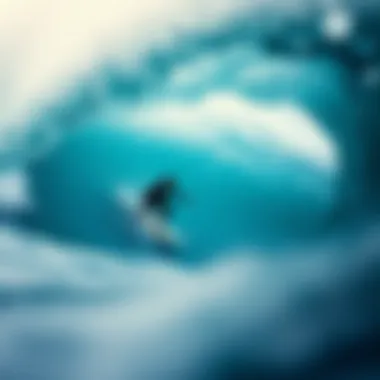Exploring Ocean Riches and Mysteries Beneath the Waves


Intro
The ocean has always been a world of wonder. Stretching across more than seventy percent of our planet, it remains largely unchartered and veiled in mystery. Yet, right beneath the waves, a treasure trove of biodiversity lurks, from colorful corals and majestic whales to tiny plankton that fuel entire ecosystems.
While adventurers have ventured to uncover its secrets, many of us still stand at the shoreline, gazing into the depths, apprehensive yet curious about what lies beneath. As our understanding of the ocean grows, so too does our appreciation of its complexity and the dire implications of human activities on its health.
From fishing practices to pollution, the impacts of humanity’s presence in marine environments cannot be ignored. This article sheds light on these oceanic wonders and the principles of sustainable management necessary to ensure their survival.
The Importance of Understanding
Being well-versed in the ocean's richness is not merely an academic exercise. It reflects the pressing need for conservation efforts as human interactions increasingly shape marine environments. As custodians of our natural world, we must be able to recognize the distinct ecosystems thriving under the waves. Furthermore, we should grasp how the geology of ocean floors plays a part in the intricate dances of marine life.
In this exploration, we’ll unveil critical aspects of marine habitats and the relentless threats they face while promoting the necessity for safeguarding these underwater realms for future generations.
Prelims to Oceanic Exploration
The ocean, often described as the final frontier on Earth, is a realm that fosters both wonder and curiosity. The exploration of these vast blue waters goes beyond mere adventure; it’s about understanding our planet's complex narratives woven into the shimmering depths. The very essence of oceanic exploration serves as a gateway to uncovering the intricate relationships between marine ecosystems and human existence. By delving into the ocean, we find not only treasures in the form of biodiversity but also a clearer picture of the many challenges that come with protecting such a vast resource.
Significance of Oceans on Earth
Oceans cover more than seventy percent of the Earth’s surface, acting as a critical regulator of our climate and weather patterns. They are the lungs of our planet, absorbing carbon dioxide and producing oxygen. Some essential points regarding the significance of oceans include:
- Biodiversity Hotspots: Oceans harbor a staggering variety of life forms, from the tiniest plankton to enormous blue whales. This diversity fuels life on land too, as many species depend on marine resources.
- Economic Resources: The ocean is a source of food, medicine, and energy. Fisheries provide livelihoods for millions, while developing technologies like wave and tidal power promise sustainable energy futures.
- Cultural Importance: Many cultures around the world have deep-rooted connections with the sea. From surfing to fishing, the ocean shapes identities and traditions.
The ocean's health directly influences not only marine inhabitants but also humanity. In a rapidly changing world, recognizing and valuing the oceans' significance is crucial for our survival and prosperity.
Historical Context of Ocean Exploration
The journey into the blue seas has evolved remarkably over centuries. Early ocean exploration was predominantly navigational, driven by the desire for land, trade routes, and resources. The Age of Discovery, from the 15th to 17th centuries, saw explorers like Columbus and Magellan venture forth into the unknown, seeking new territories and riches. This pursuit laid the groundwork for modern geographical knowledge.
As we moved into the 19th century, the focus shifted toward scientific inquiry. The HMS Challenger expedition from 1872 to 1876 is often recognized as the first true scientific deep-sea exploration. This monumental voyage led to the discovery of numerous marine species and contributed to our understanding of ocean currents and geology.
In the years following, innovations such as sonar and submersibles opened new doors. The 20th century’s race to explore the depths unveiled mysteries of the ocean floor, revealing chaotic trenches and underwater volcanoes. Today, scientists employ sophisticated robots and satellites, expanding our horizons in ocean research.
The lens through which we view oceanic exploration reflects our growing consciousness of the ocean’s importance—its intricate systems, its ecological wealth, and the threats looming from human activity. Understanding this context is vital as we step into an era where stewardship of the ocean is essential for our collective future.
Marine Ecosystems: A Detailed Overview
Marine ecosystems play a critical role in the health of the planet and the well-being of its inhabitants. They are not just about beauty and biodiversity; they also provide essential services that sustain life both in the water and on land. From the vibrant colors of coral reefs to the shadowy realms of the deep sea, these ecosystems reflect the intricate balance of nature and the vital connections that exist within the ocean's depths.
The importance of understanding marine ecosystems lies in their biodiversity and productivity. They serve as habitats for an astounding variety of species, many of which have not yet been explored or documented. In fact, around 230,000 marine species have been described, yet scientists estimate that over two million could still be undiscovered. This potential for discovery highlights the rich resources we have within our ocean environments. Moreover, these systems regulate climate, provide food, and support livelihoods, which makes a thorough understanding of marine ecosystems vital for sustainable practices.
Coral Reefs: The Rainforests of the Sea
Coral reefs, often dubbed the rainforests of the sea, are among the most diverse ecosystems on the planet. They cover only about 1% of the ocean floor, but they support nearly 25% of all marine species. These vibrant underwater gardens are not only crucial for marine biodiversity but also protect coastlines from erosion, support fisheries, and attract tourism.
Coral reefs are built from the calcium carbonate skeletons of corals, which are living organisms that thrive in warm, shallow waters. They rely on a symbiotic relationship with zooxanthellae, tiny algae that live within coral tissues. This relationship not only gifts the reefs their colorful hues but also provides energy through photosynthesis.
- Biodiversity Hotspot: Coral reefs are teeming with life, offering a refuge for thousands of species.
- Economic Value: They are essential for local fisheries and tourism, contributing billions to the global economy.
- Ecosystem Services: Reefs act as natural barriers against storm surges and mitigate coastal erosion, making them vital for protecting coastal communities.
Despite their importance, coral reefs are under severe threat from climate change, pollution, and overfishing. Actions to protect and rejuvenate these ecosystems are not only necessary but urgent.
"Coral bleaching, caused by rising sea temperatures, shows how interconnected our environment is and highlights the impact of global warming on our oceans."
Deep-Sea Ecosystems: Life in Extremes
Beneath the surface, in the darkest depths of the ocean, lies an extraordinary world. Deep-sea ecosystems, which include hydrothermal vents and cold seeps, host unique life forms adapted to extreme conditions such as high pressure and complete darkness. Unlike their shallow-water counterparts, these ecosystems are often isolated and can support species that are peculiar to their environments.
Hydrothermal vents, for instance, are akin to underwater geysers, releasing mineral-rich water that supports communities of organisms, including giant tube worms and unique species of shrimp. These organisms rely on chemosynthesis rather than photosynthesis – creating food through chemical reactions rather than sunlight. Some key features of these ecosystems include:


- Unique Adaptations: Organisms possess incredible adaptations for survival, making them excellent subjects for biological research.
- Potential Discoveries: The deep sea may hold undiscovered species and resources, such as new pharmaceuticals.
- Climate Regulation: Deep-sea ecosystems play a role in carbon cycling, potentially influencing climate patterns.
Research into these depths continues to reveal wonders we hardly understood before, emphasizing the need for exploration and conservation to preserve these fragile habitats.
Estuaries: Where Land Meets Sea
Estuaries are often described as the nurseries of the sea. They are transitional areas where freshwater from rivers meets the saltwater of the ocean, creating rich and productive environments. The mixing of these waters leads to high nutrient levels, supporting a variety of plant and animal life.
These areas are incredibly important for several reasons.
- Biodiversity and Species Breeding: Estuaries serve as crucial habitats for fish, birds, and other wildlife, playing a significant role in their life cycles.
- Economic Importance: They provide valuable resources including fish, shellfish, and recreational areas that benefit local economies.
- Natural Filters: Estuaries mitigate pollution by filtering runoff before it enters the ocean, providing clean waters that protect marine life.
However, estuaries face threats from development, pollution, and climate change, which can disrupt the delicate ecosystems they support. Protecting these unique environments is essential not only for wildlife but for human communities that rely on the resources they provide.
In summary, marine ecosystems are essential to life on Earth. Their uniqueness and productivity underscore the importance of understanding and preserving them. As we continue to explore and uncover the mysteries of the ocean, it becomes apparent that our future is intertwined with the health of these environments.
Diversity of Marine Life
Understanding the diversity of marine life is crucial for gaining insight into the ocean's multifaceted ecosystem. The vastness of the ocean harbors an astonishing variety of species, adapted over millions of years to survive in environments ranging from sunlit coral reefs to the inhospitable depths of the Mariana Trench. This diversity is not just a spectacle of nature; it is the backbone of vital ecological processes and provides numerous benefits to humanity. Marine biodiversity contributes to fisheries, tourism, and is essential for maintaining the planet's health.
Additionally, the intricate relationships among species, as well as their adaptability, make studying marine life imperative for conservation efforts. A decline in any one species can have cascading effects throughout the ecosystem, ultimately impacting food security and climate regulation. By recognizing the value of marine biodiversity, we can formulate strategies for sustainable management and protection of our oceans.
Fish Species: Adaptations and Survival
Fish are incredibly diverse, showcasing a myriad of adaptations that enable them to thrive in various marine environments. Think about the bright colors of the clownfish or the predatory efficiency of the great white shark. These visual traits and physical structures are not just for show; they serve critical functions in survival.
Many fish species have developed special mechanisms to cope with their surroundings. For instance, the anglerfish uses bioluminescence to lure prey in the dark depths of the ocean. Likewise, schools of sardines provide a tactical advantage against predators by moving in unison, creating a more formidable barrier.
- Camouflage is fundamental - species like the flounder can change their skin patterns to blend seamlessly with the ocean floor.
- Behavioral strategies - schooling and packing behaviors enhance survival chances against predators.
- Physiological adaptations - fish can regulate their buoyancy and swim at various depths, depending on their habitat needs.
These adaptations illustrate the resilience of marine life, emphasizing the importance of preserving such biodiversity.
Marine Mammals: Intelligence and Social Structures
Marine mammals, including dolphins, whales, and seals, exhibit remarkable intelligence and complex social structures that often mirror human societies. Their ability to communicate and form social bonds challenges our understanding of consciousness in non-human beings.
Take the orcas for example. Known as killer whales, they live in tight-knit family groups known as pods. Each pod has its own dialect and hunting strategies, showcasing a rich cultural heritage that gets passed down through generations. Similarly, dolphins are known for their playful nature and advanced problem-solving skills, which they showcase through intricate play and cooperation.
- Communication - Echolocation allows marine mammals to navigate and hunt efficiently.
- Social behavior - Many species exhibit unique social interactions, including cooperative hunting and altruism.
- Learning and memory - Studies show that they have impressive memory capabilities, often recalling complex tasks.
Exploring the social structures of marine mammals not only reveals the intricate workings of their communities, but also provides us with lessons about empathy and connection.
Invertebrates: The Backbone of Ocean Biodiversity
Often overshadowed by more charismatic marine life, invertebrates represent a significant proportion of ocean biodiversity. Consisting of creatures like jellyfish, octopuses, and sea urchins, these animals play critical roles in marine ecosystems. Their diversity offers a wealth of benefits, from maintaining ecological balance to driving nutrient cycles.
For example, coral polyps, tiny invertebrates, build massive reefs that serve as habitats for countless marine species. Surprisingly, even the much-despised sea slugs possess colorful adaptations that not only aid their survival but also add vibrancy to the underwater world.
- Role in food webs - Invertebrates serve as prey for larger species, forming the base of many marine food webs.
- Ecosystem engineers - They modify their habitat, such as the reef-building capabilities of corals.
- Sensitivity to change - Many invertebrates are bellwethers for environmental changes, highlighting the health of marine ecosystems.
Recognizing and protecting the vast world of invertebrates is essential for ensuring the stability and diversity of the ocean as a whole.
Geological Features of the Ocean Floor
The geological features of the ocean floor are diverse and critical in understanding the dynamics of the Earth’s systems. These structures not only shape oceanic environments but also influence global climate patterns, marine biodiversity, and even human activities like fishing and oil extraction. The ocean floor is a canvas painted by various geological processes that have taken place over millions of years. Recognizing these features can help us grasp the complexities of marine ecosystems and the vital resources they harbor.
Mid-Ocean Ridges: Birthplaces of New Oceanic Crust
Mid-ocean ridges are these breathtaking underwater mountain ranges formed by tectonic plates pulling apart. As these plates separate, magma erupts from the mantle to create new oceanic crust. This process, often referred to as seafloor spreading, plays a pivotal role in the geological dynamics of our planet. The Mid-Atlantic Ridge, for instance, is a prime example where North America and Eurasia are drifting apart at a noticeable rate.
The significance of mid-ocean ridges extends beyond just geology. They create unique habitats for marine life. Hydrothermal vents, often found along these ridges, spew nutrient-rich water, supporting complex ecosystems that rely on chemosynthesis instead of sunlight. Some organisms, like tube worms and giant clams, thrive in these extreme environments, demonstrating the ocean’s resiliency and adaptability. These ridges also serve as crucial areas for oceanic research, offering insights into plate tectonics and the earth's formation.


Ocean Trenches: The Deepest Places on Earth
Ocean trenches are where the drama of the Earth's geology truly unfolds. These deep trenches, like the Mariana Trench, can plunge more than 10 kilometers below sea level. Subduction zones create these features when one tectonic plate is forced beneath another, an area often rich in geological activity and natural resources.
Exploring ocean trenches presents both challenges and rewards. These extreme environments are among the least explored areas on Earth. The conditions are harsh, with immense pressure and darkness, yet they harbor some of the most unique life forms—creatures like the giant squid and various bioluminescent species—whose adaptations continue to mystify scientists. Additionally, ocean trenches serve as critical indicators of geological activity and earthquake potential, underscoring their importance in understanding our planet’s health.
Seamounts: Underwater Mountains Rising from the Depths
Seamounts, or underwater mountains, rise steeply from the ocean floor but do not break the surface of the water. These submerged giants are often volcanic in origin and can be key players in marine ecosystems. With thousands identified around the world, seamounts act as biodiversity hotspots. They provide critical habitats for many fish species, serving as spawning grounds and offering refuge from predators.
The unique topography of seamounts creates upwellings that bring nutrient-rich water from the depths to the surface, fueling vibrant marine life. For instance, species like coral and various fish congregate around these structures, creating ecosystems that rival those of coral reefs in terms of biodiversity. Furthermore, seamounts are of increasing interest for their potential economic value, including fisheries and possible new pharmaceutical discoveries from unique marine organisms inhabiting these regions.
Human Impact on Oceans
The interplay between humankind and the ocean is a complex tapestry woven with threads of both dependence and neglect. Recognizing how our actions shape marine environments is crucial, especially as we navigate the implications of human presence on oceanic ecosystems. This section sheds light on how pollution, overfishing, and climate change converge to pose a significant threat to the delicate balance of oceanic life.
Pollution and Its Effects
Pollution in its myriad forms infiltrates our oceans, leaving a profound mark on marine life. From plastic waste swamping our beaches to chemical runoff infiltrating delicate coral reefs, the impact is staggering. Microplastics, tiny particles resulting from the breakdown of larger items, have even been discovered in the stomachs of various species, disrupting food chains and affecting biodiversity. The implications go beyond just marine inhabitants; these pollutants can infiltrate the human food chain as well.
The presence of pollutants can lead to toxic algae blooms, a phenomenon prompted by nutrient runoff from urban and agricultural areas. These blooms can suffocate marine life, robbing oxygen from the water and creating dead zones where life is unsustainable.
"The scale of ocean pollution mirrors the pace at which we consume, a hard lesson about the limits of our resources and the responsibility we bear for stewardship of our oceans."
To combat pollution, efforts are underway, such as beach clean-ups and legislation for stricter waste management policies. However, it’s clear that individual actions, like reducing plastic use and supporting sustainable brands, can also contribute significantly to mitigating this issue.
Overfishing: A Threat to Marine Biodiversity
Overfishing represents another daunting challenge facing our oceans. The insatiable demand for seafood leads to the depletion of fish populations beyond sustainable levels. Popular species such as bluefin tuna and cod are nearing collapse, posing risks not just to their survival but to the entire ecosystem that depends on them.
The bycatch phenomenon exacerbates this issue. While targeting specific fish, many other marine creatures, including sea turtles and sharks, end up caught in the nets, resulting in significant unintentional killing. This indiscriminate approach to fishing disrupts natural habitats and hinders recovery efforts for these species.
Without effective management and adherence to sustainable fishing practices, we risk losing vital components of marine ecosystems that support not only marine biodiversity but human economies reliant on fishing. Educational campaigns aimed at consumers to choose sustainably sourced seafood can empower individuals to make a difference.
Climate Change and Ocean Acidification
Climate change casts a long shadow over our oceans, manifesting as rising temperatures and altered weather patterns. These changes are not merely future worries—they are pressing realities that affect ecosystems today. One direct consequence is ocean acidification, a process where the ocean absorbs excess atmospheric carbon dioxide, leading to a decline in the pH levels of seawater.
This acidification impacts calcifying organisms, like corals and shellfish, hindering their ability to build shells and skeletons. The resulting weakened structures can diminish reef resilience, consequently affecting the myriad species that rely on these habitats for survival.
Moreover, increasing ocean temperatures lead to coral bleaching, a phenomenon where stressful conditions cause corals to expel the algae living in their tissues. This leaves the corals white and vulnerable, potentially leading to mass die-offs if conditions do not improve.
As we face these challenges, a collaborative approach involving scientists, policymakers, and communities is indispensable. Projects to monitor ocean health and advocate for immediate action on climate change are crucial for sustaining the health of our oceans.
In closing, understanding the human impact on oceans is not just an academic endeavor—it is a call to action to preserve the vital role oceans play in supporting life on Earth. With awareness and responsibility, we can steer towards a future where marine ecosystems thrive alongside human endeavors.
Conservation and Preservation Efforts
Conservation and preservation efforts in the marine environment are paramount to maintaining the delicate balance of oceanic ecosystems. As stewards of this planet, it is our duty to foster an environment where both human activities and marine life can coexist sustainably. With the oceans facing numerous threats—from pollution and climate change to overfishing—taking action is not just important; it's essential.
Efforts like establishing marine protected areas, promoting sustainable fishing practices, and engaging local communities in conservation are vital strategies. These initiatives serve various purposes, such as safeguarding biodiversity, enhancing resilience against climate change, and ensuring that future generations can enjoy and benefit from the oceans.
"Preservation is not just about saving what is beautiful; it is about securing our future as well."
Marine Protected Areas: Safeguarding Biodiversity
Marine protected areas (MPAs) play a crucial role in safeguarding biodiversity. By restricting human activities in specific regions, these zones allow ecosystems to thrive without interference.
- Habitat preservation: MPAs protect critical habitats like coral reefs and seagrass beds. They provide fish and other marine animals with breeding grounds, enhancing populations that might otherwise be endangered.
- Monitoring and research: These areas often become hotspots for scientific research, giving us a deeper understanding of marine life and ecosystems.
- Fisheries management: By limiting where fishing can occur, MPAs can help restore fish stocks, leading to more sustainable practices and long-term viability.


Implementing MPAs is a collaborative effort requiring input from scientists, policy makers, and local communities to ensure that they meet ecological goals while honoring cultural practices.
Sustainable Fishing Practices
Sustainable fishing practices look to balance the needs of people with the health of ocean ecosystems. The aim is to catch fish and seafood in a way that ensures populations remain stable.
- Limit catch sizes: Regulating how much fish can be caught helps maintain stocks at healthy levels.
- Selectivity in gear: Using gear that minimizes bycatch protects other marine species that might otherwise be unintentionally captured.
- Seasonal closures: Allowing certain species to spawn before they are caught ensures that populations can rejuvenate, sustaining fisheries over the long term.
Adopting these practices requires a commitment from fishermen, communities, and consumers alike. Supporting fisheries that employ sustainable methods encourages a shift towards healthier oceans.
Community Involvement in Conservation
Engaging communities in conservation strategies is often a game-changer. When local stakeholders are involved, initiatives tend to be more successful and sustainable.
- Education and awareness: Programs that inform locals about the importance of marine ecosystems promote stewardship and respect.
- Citizen science: Involving the community in data collection and monitoring fosters ownership and investment in local marine health.
- Cultural practices: Integrating traditional knowledge with modern science leads to holistic management strategies that are culturally inclusive and effective.
Community involvement not only enhances conservation efforts but also strengthens the bond between people and the ocean. When individuals feel a stake in their environment, they are more likely to protect it.
For more insights on marine conservation, check out resources like NOAA Fisheries and The Nature Conservancy.
Future of Ocean Exploration
As we gaze out over the endless blue expanse, it becomes increasingly apparent that the future of ocean exploration is not just about discovery; it’s about preservation, sustainability, and understanding our place within the delicate marine ecosystem. The oceans are not merely vast, beautiful bodies of water. They are intricate networks that provide essential resources and influence global climates. Given this, unraveling their mysteries holds paramount importance for future generations.
Technological Advancements in Marine Research
With the rapid pace of technology, marine research has entered a new era. Traditional methods of exploration often relied heavily on human observation and limited tools. Nowadays, innovations such as autonomous underwater vehicles (AUVs) and remotely operated vehicles (ROVs) are revolutionizing our capacity to investigate the deep sea. These advanced technologies provide us the ability to explore areas previously deemed inaccessible due to their depths or harsh conditions.
For instance, the Okeanos Explorer, an NOAA ship, employs ROVs equipped with high-definition cameras, allowing scientists to document marine life and geological formations more effectively than ever before. As these technologies become more affordable and accessible, a broader range of researchers, including colleges and independent teams, can join the quest. Their discoveries will further enhance our collective knowledge about the uncharted territories beneath the waves.
Moreover, technological advancements are not only changing how we explore but also improving how we interact with the data collected. Big data analytics allows researchers to parse through vast amounts of information, connecting dots that were once too far apart to grasp. This ability to synthesize data leads to quicker, evidence-based decisions that can benefit both science and our oceans.
The Importance of Data Collection and Analysis
The lifeblood of ocean exploration is data. Collecting accurate and comprehensive data is crucial as it lays the groundwork for our understanding of marine ecosystems. From tracking fish populations to measuring temperature fluctuations and noticing shifts in ocean currents, data is what shapes our understanding of environmental changes and human impacts.
"The sea, once it casts its spell, holds one in its net of wonder forever."
This quote by Jacques Cousteau encapsulates the essence of why data collection is essential. In this era of climate change and rising pollution levels, having precise data helps us respond promptly to deteriorating marine environments. For example, monitoring and analyzing ocean acidification through data collection has become vital for adjusting fishing quotas and ensuring the health of coral reefs.
Furthermore, data-sharing among scientists globally fosters collaboration and provides a comprehensive understanding of marine dynamics. Online databases and platforms have emerged where researchers can contribute and access vital statistics, making it possible to build upon one another's findings. This interconnectedness is more than just beneficial; it's essential in tackling the complex challenges our oceans face today.
As we look ahead, the future of ocean exploration seems to hold promises of innovation and collaboration. If these advancements continue to evolve, so too will our relationship with the oceans, steering us toward a path of greater understanding and respect for the blue planet we call home.
Ending: Understanding the Ocean's Value
The ocean exemplifies a magnificent entity that is not only vast but also intricate, serving as a fundamental pillar in the support of life on our planet. Through various sections of this article, we have traversed the richness of marine ecosystems, the geological marvels beneath the surface, and the serious threats posed by human actions. Tying these strands together underscores one glaring truth: the ocean's value extends beyond its beauty; it is a treasure trove of biodiversity and essential resources that we have barely begun to comprehend.
Reflecting on our relationship with the sea reveals deep connections; it sustains us through food, climate regulation, and even recreation. Fishing, for example, goes way beyond just an industry; it brings communities together, binds cultures, and nourishes millions. However, each effort to exploit this wealth comes at a cost. Understanding the ocean's complexity and fragility encourages us to think more critically about how our actions influence its health.
Reflecting on Our Relationship with the Sea
Consider how intimately intertwined human life is with oceanic health. For some, the ocean might simply be a backdrop for vacations; for others, it's a front-line source of livelihood. The rhythms of the tides mimic life's ups and downs, continually reminding us of our dependence on this majestic body of water.
The ocean holds cultural stories, from fishermen's lore to surfers' experiences riding the waves. Yet, with each rising tide of pollution or habitat destruction, we risk losing more than we can imagine. The ongoing degradation of coral reefs, for instance, signifies not just loss of biodiversity but also a deep-rooted connection severed between people and their environment. Understanding this relationship criticizes the superficial appreciation many have and prods us towards deeper respect and actionable stewardship.
Encouraging Knowledge for Future Generations
As we draw the curtain on our oceanic exploration, the crux lies in promoting a stewardship mindset among future generations. Education plays a pivotal role here. Just as the ocean teems with life, knowledge should flow freely, spurring curiosity about marine environments. By instilling appreciation for this vast world, we cultivate not just informed future adults but stewards passionate about protecting these precious ecosystems.
We can create curricula that emphasize the importance of sustainable practices. Schools could organize field trips to aquariums or marine reserves—tangible experiences that ignite interest and respect. Moreover, community initiatives could involve local populations in cleanup activities, engaging in hands-on learning while fostering a sense of responsibility.
Further, leveraging digital platforms can extend these efforts globally. Information on marine health, pollution consequences, and conservation techniques could circulate in online forums and blogs, empowering people to share knowledge and resources. Websites like NOAA and National Geographic offer an abundance of reliable information, and social media platforms can spark global conversations about marine conservation.
"We do not inherit the earth from our ancestors; we borrow it from our children."
This poignant quote encapsulates our obligation towards the ocean—a duty to ensure that it remains vibrant and robust for those who will walk this planet after us. Our shared understanding of the ocean’s value lays the groundwork for a healthy and sustainable future, empowering not just ourselves but generations yet to come.







